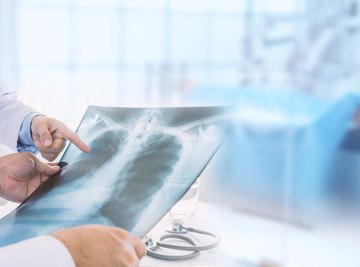
Pulmonary alveoli are the tiny, elastic sacs in animal lungs that fill with air upon inhalation and are compressed to squeeze it out of the body upon exhalation. Each human lung contains roughly 300 million alveoli. Alveolar cells include two types of pneumocytes, which are cells that make up the wall of each aveolus, and one type of macrophage, or immune system cell.
Structural Scales
Type 1 alveolar cells are also known as squamous alveolar cells. "Squamous" means "scale-like" and they can be distinguished by their flat shape. These cells are epithelial, which means they form a membrane, in this case the wall of the alveoli. Their functions include providing physical structural support for the alveoli and facilitating the fast exchange of gases. These type 1 squamous cells cover 95 percent of the surface area of each alveolus.
Soapy Handymen
Type 2 pneumocytes are also called great alveolar cells. They can be distinguished by their cuboidal, round or cubed, shape. Their functions include production of the soap-like surfactant that prevents the alveoli from collapsing upon exhalation; and repair of the alveolar wall by replacing both damaged type 1 and type 2 alveolar cells. They are actually more numerous than the type 1 alveolar cells, but make up only 5 percent of the alveolar wall surface area.
Munching Macrophages
Alveolar macrophages are also called "dust cells." These white blood cells are distinguished by their large shape, mobility, relatively low numbers and predatory habits. They engulf and destroy invading microorganisms, and also sweep up any debris that may have entered the lung when inhaling. A few macrophages are embedded in the connective tissue between alveoli, while many more move around in the interior of alveoli, hunting foreign invaders.
Getting a Sample
To identify the different alveolar cells in lung tissue, first you need a sample. In human diagnostic procedures, a tissue sample is extracted either through bronchoalveolar lavage, BAL, where fluid is sucked out of the lungs of a sedated patient through a tube, or through biopsy. BAL is used in cases where the lungs contain abnormal fluid, such as fluid accumulation due to pneumonia, and collects dead or dying cells sloughed from the alveolar walls. Biopsy removes a chunk of living tissue, usually by a needle inserted through the upper torso wall. Studies of lung cells from a dead or living individual usually involve a thin sheet of dried tissue or a small sample of cells mixed in solution and mounted on a microscope plate.
Positive ID
Identifying the different types of alveolar cells is usually a matter of simply observing them under a microscope and noting their shapes and features. In a whole tissue mount, their location will also give a clue to their identity. Identification can be facilitated by various staining procedures. These procedures use different kinds of dyes to make some types of cell more visible than others against the background of the microscopic slide. Cell shapes and internal structures are revealed.
About the Author
Angela Libal began writing professionally in 2005. She has published several books, specializing in zoology and animal husbandry. Libal holds a degree in behavioral science: animal science from Moorpark College, a Bachelor of Arts from Sarah Lawrence College and is a graduate student in cryptozoology.
